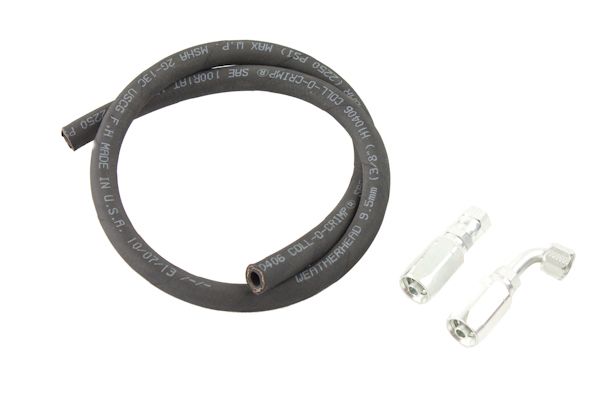A high-pressure power steering hose is a crucial component that carries pressurized fluid between the power steering pump and the steering gear. It is responsible for transmitting hydraulic power, allowing for easy steering maneuverability.
The hose is designed to withstand high pressure and ensure a leak-free system, preventing loss of power steering fluid. Regular inspection and maintenance of the power steering hose are essential to ensure optimal performance and prevent potential steering issues.

Credit: pbhperformance.com
Contents
Identifying High Pressure Power Steering Hose Leaks
Common Symptoms Of A Leak
1. Fluid Drips: Under the vehicle, look for puddles of power steering fluid.
2. Whining Noise: When turning the steering wheel, listen for a high-pitched whining sound.
Inspection Techniques For Pinpointing Leaks
- Visual Inspection: Look for cracks, bulges, or wet spots on the hose.
- Using UV Dye: Add UV dye to the power steering system and use a UV light to identify the source of the leak.
- Pressure Test: Apply pressure to the system to pinpoint the exact location of the leak.

Credit: www.amazon.com
Diy Leak Repair: Step-by-step Guide
Dealing with a high pressure power steering hose leak can be a daunting task, but with the right tools and a step-by-step approach, it’s a repair you can tackle yourself. Follow this guide to learn how to remove the faulty hose and install a new one, saving both time and money.
Tools And Materials Needed
- Jack and jack stands
- Wrench set
- Power steering fluid
- Protective gloves and eyewear
- New high pressure power steering hose
- Shop rags
Safety Precautions Before Starting
Prior to beginning the repair, ensure the vehicle is on a level surface and the engine is cool. Always wear protective gloves and eyewear to prevent any fluid from coming into contact with your skin or eyes. Additionally, use jack stands to support the vehicle safely.
Removing The Faulty Hose
First, locate the high pressure power steering hose, typically connected to the power steering pump and the steering gear. Use the appropriate wrench to loosen and remove the fittings at each end of the hose. Be prepared for some power steering fluid to leak out during this process, so have shop rags handy to contain any spills.
Once the fittings are removed, carefully extract the old hose from the vehicle, taking note of its routing for installation of the new hose.
Installing The New Power Steering Hose
- Before installing the new hose, ensure all fittings and connections are clean and free of debris. This will help prevent any contamination of the power steering system.
- Next, carefully thread the new hose into place, following the same routing as the old hose. Use the wrench to secure the fittings at each end, ensuring they are tightened to the manufacturer’s specifications.
- Once the new hose is in place, refill the power steering fluid reservoir with the appropriate fluid and start the engine. Turn the steering wheel from lock to lock several times to purge any air from the system.
Preventive Measures And Maintenance Tips
When it comes to maintaining the high pressure power steering hose of your vehicle, preventive measures and regular maintenance are key to ensuring its longevity and optimal performance. By adhering to a proper maintenance routine, you can prevent potential issues and prolong the lifespan of your power steering hose.
Regular Inspection Intervals
Regular inspections at specified intervals help in identifying potential issues before they escalate. Inspect the hose for cracks, leaks, and signs of wear. Pay attention to connections and fittings as well to ensure proper sealing.
Proper Fluid Replacement Schedules
Follow the manufacturer’s recommendations for power steering fluid replacement. Contaminated fluid can lead to premature hose failure. Ensure the fluid level is maintained within the recommended range to prevent strain on the hose.
Avoiding Common Causes Of Wear And Tear
- Shield the hose from excessive heat sources such as the exhaust manifold.
- Avoid sharp turns when the steering is at full lock to prevent undue stress on the hose.
- Regularly check for loose or damaged components that may cause rubbing or chafing against the hose.

Credit: www.pscmotorsports.com
Frequently Asked Questions
Here are some FAQs about the high pressure power steering hose –
Why Is A Quality Power Steering Hose Important?
A quality power steering hose ensures smooth steering operation and prevents leaks.
How Can I Tell If My Power Steering Hose Is Failing?
Look for signs like fluid leaks, difficulty steering, or strange noises when turning the wheel.
Can I Replace A Power Steering Hose Myself?
Replacing a power steering hose requires technical knowledge and is best done by professionals.
What Are The Consequences Of Driving With A Damaged Hose?
Driving with a damaged power steering hose can lead to loss of steering control.
How Often Should I Replace My Power Steering Hose?
It is recommended to inspect and replace the power steering hose every 60,000 miles.
Conclusion
To sum up, a high-pressure power steering hose plays a crucial role in the smooth functioning of a vehicle’s steering system. Its durability and efficient performance ensure precise control and maneuverability on the road. Regular maintenance and timely replacement of worn-out hoses are essential to avoid potential risks and ensure a safe driving experience.
By understanding the importance of a high-quality power steering hose, you can ensure the longevity and reliability of your vehicle’s steering system.